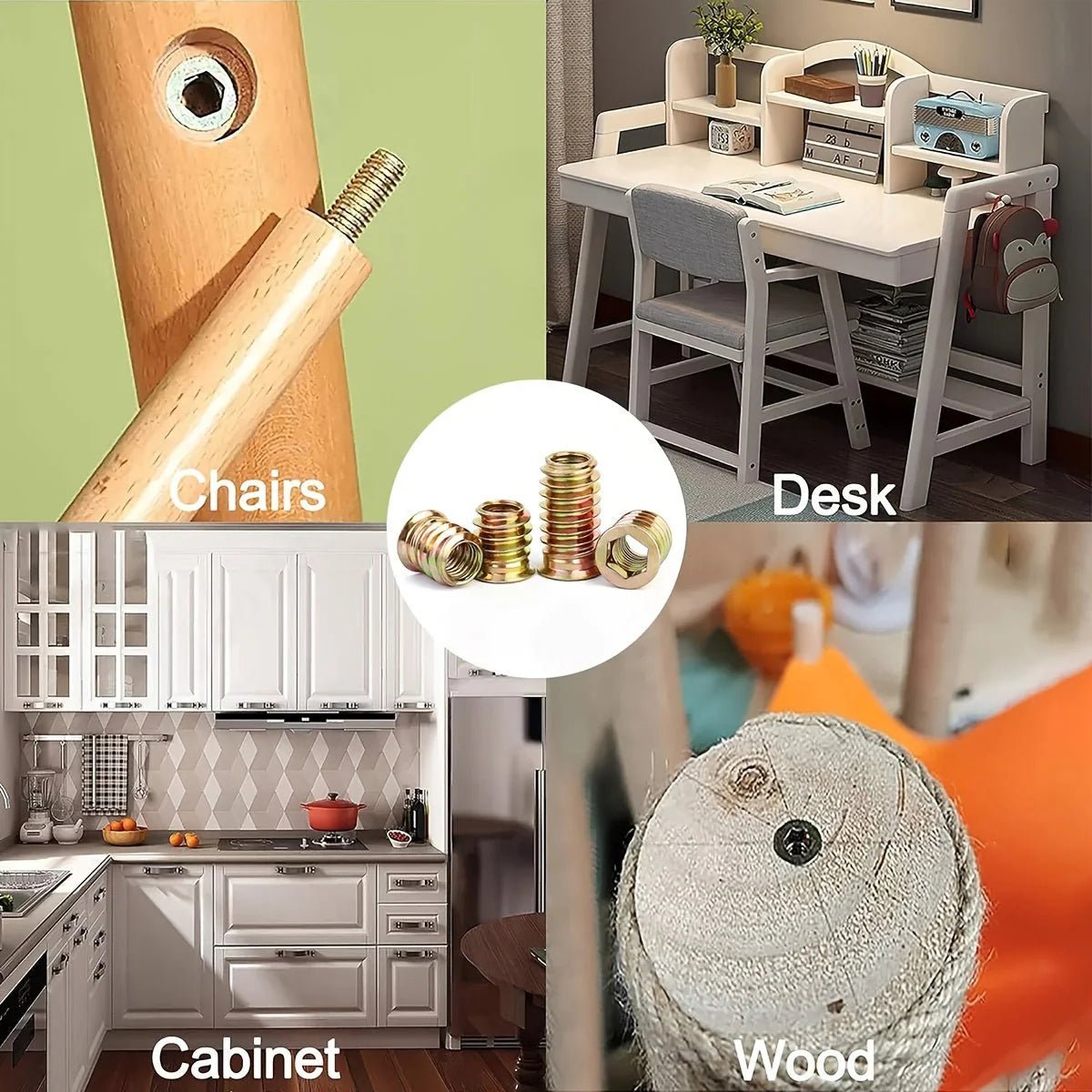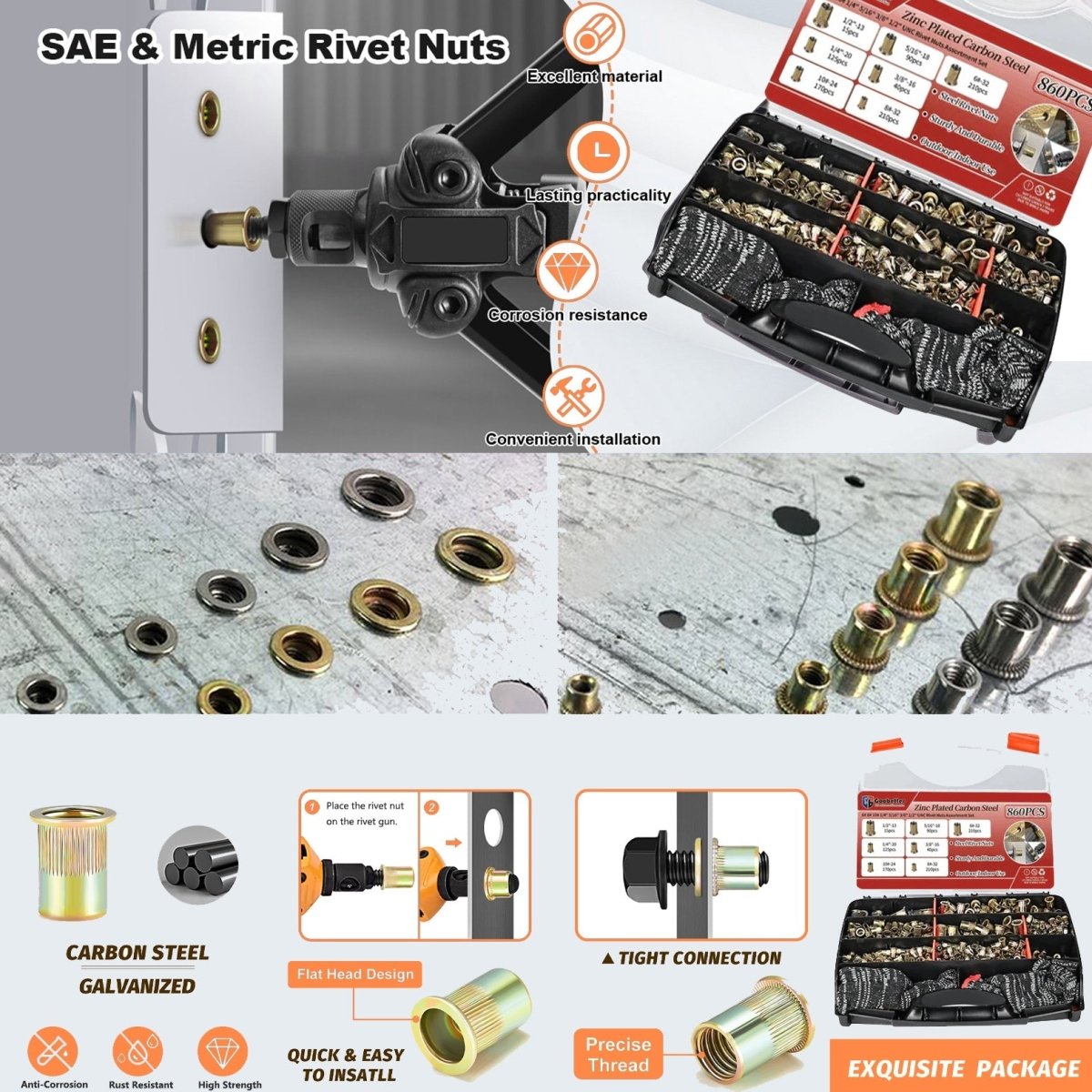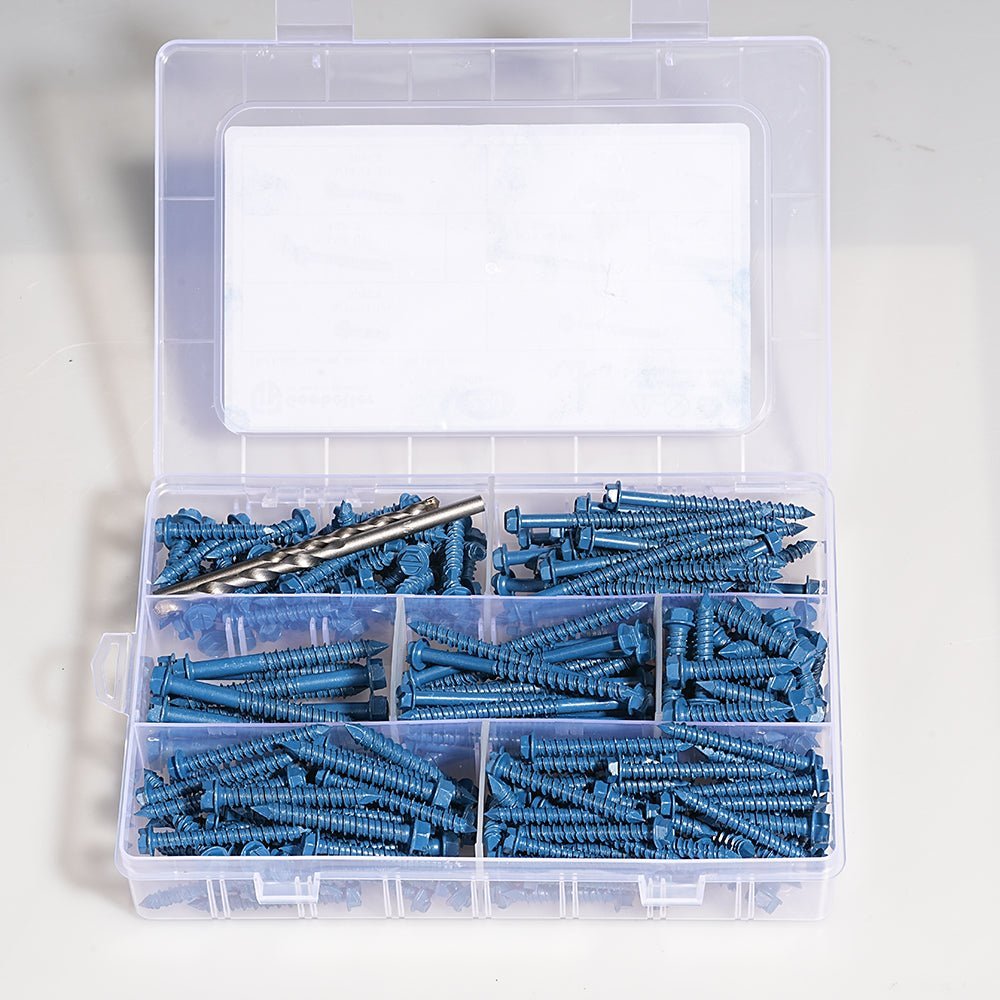Table of Contents
-
The Great Wood-Fastening Debate
-
How Screws Work (And Why They Fail)
-
Threaded Inserts 101: What They Are & How They Work
-
Head-to-Head: Strength Comparison
-
When Threaded Inserts SHINE (And When Screws Win)
-
Pro Installation Guide: Mastering Threaded Inserts
-
Why Our 162pc Hex-Drive Kit Solves Your Biggest Headaches
-
Real-World Applications: Furniture, Workshops & Beyond
-
FAQs: Your Insert Questions Answered
-
The Final Verdict: Building to Last
1. The Great Wood-Fastening Debate
Woodworking forums are littered with stripped screws, cracked Ikea furniture, and the eternal question: “How do I make this connection LAST?” Screws feel intuitive—you drill, drive, and walk away. But seasoned builders know better. That wobbly barstool? The shelf that sags after 6 months? The table leg that spins freely? All scream “wrong fastener choice.”
Threaded inserts (aka helicoils for wood) look deceptively simple—brass or steel sleeves with internal machine threads. But their magic lies in redistributing force. Unlike screws that bite directly into vulnerable wood fibers, inserts create a hardened metal tunnel, letting bolts clamp joints without crushing the material. The catch? They’re misunderstood. Let’s cut through the noise.
2. How Screws Work (And Why They Fail)
The Mechanics
-
Bite & Hold: Screw threads wedge between wood fibers (like a ramp forcing fibers apart).
-
Friction = Strength: Holding power relies entirely on fiber integrity.
-
The Weak Points:
-
Softwoods/Particleboard: Fibers crush under load → threads strip.
-
Cross-Grain Joinery: Seasonal wood movement loosens grip.
-
Over-Tightening: Heads sink, fibers split, connection fails.
-
Repeated Assembly: Threads wear out after 2-3 re-tightenings.
-
Where Screws Fail Hard
“I used #10 screws in my MDF shelf… it collapsed under books!”
-
Particleboard/MDF: Crumbles like granola under thread pressure.
-
Thin Stock: Requires short screws → minimal thread engagement.
-
End Grain: Threads hold poorly (like screwing into broom bristles).
3. Threaded Inserts 101: The Underdog Solution
What They Are
-
External Threads: Bite into wood (coarse, aggressive spirals).
-
Internal Threads: Accept machine bolts (fine, precise threads).
-
Materials Matter:
-
Brass: Corrosion-resistant for indoor/humid spaces.
-
Zinc-Plated Steel: Max strength for structural loads.
-
Flange Design: Prevents spinning during bolt tightening.
-
How They Outsmart Wood’s Weaknesses
-
Force Distribution: Load spreads along the insert’s entire length (not just thread tips).
-
Reinforced Tunnel: Bolt threads engage metal, not vulnerable wood fibers.
-
No Compression: Bolts clamp joints without crushing soft materials.
-
Rebuildability: Swap bolts 50+ times without wear.
4. Head-to-Head: Strength Showdown
| Test | Wood Screws | Threaded Inserts | Winner |
|---|---|---|---|
| Pull-Out Strength (Particleboard) | 80-120 lbs | 250-400+ lbs | ✅ Inserts by 3x |
| Stripping Resistance | Low (fibers tear) | Extreme (metal-on-metal) | ✅ Inserts |
| Shear Strength | ✅ Good (shank resists snapping) | Moderate (bolt determines strength) | ⚠️ Screws |
| End-Grain Holding | Poor | Excellent | ✅ Inserts |
| Reassembly Cycles | 2-3 before failure | 50+ | ✅ Inserts |
| Material Versatility | Softwoods ✅ | Hardwoods ✅ Plywood ✅ Particleboard ✅ | ✅ Inserts |
Key Insight: Inserts dominate in pull-out strength and rebuildability—critical for furniture legs, bench vises, and shelf brackets. Screws win for shear loads (like framing).
5. When Threaded Inserts SHINE (And When Screws Win)
Use Threaded Inserts When:
-
Working with Particleboard/MDF (Ikea hacks, speaker boxes).
-
Frequent Disassembly Needed (workbench jigs, stage gear).
-
Bolting Metal-to-Wood (table legs, machinery bases).
-
Hardwoods/End Grain (chair repairs, turning projects).
-
Preventing Over-Tightening Damage (guitar builds, thin panels).
Stick with Screws When:
-
Solid Wood Framing (stud walls, deck joists).
-
Speed > Precision (quick shop projects).
-
High Shear Loads (shelf standards, drawer slides).
-
Cost-Sensitive Bulk Work (rough carpentry).
6. Pro Installation Guide: Master Threaded Inserts
Tools You’ll Need
-
162pc Hex-Drive Insert Kit (includes inserts + driver bits)
-
Drill + Drill Bits (pilot + clearance sizes)
-
Hex Key/Driver Bit
-
Beeswax or Bar Soap (lubricant)
Step-by-Step
-
Drill Pilot Hole:
-
Match hole size exactly to insert’s specs (too big = weak, too small = splits wood).
-
Pro Tip: For hardwoods, drill 1/64" larger to prevent cracking.
-
-
Lubricate External Threads:
-
Rub threads with beeswax—never glue (reduces friction, prevents wood splitting).
-
-
Drive Insert FLUSH:
-
Use hex key + slow-speed drill. Stop when flange touches wood.
-
⚠️ Critical: Over-driving cracks wood around the insert!
-
-
Install Bolt:
-
Hand-tighten first, then torque to spec (insets won’t strip like wood).
-
Avoid These Blunders:
Skipping lube → Split oak tabletop.
Wrong pilot hole → Spinning insert (epoxy fix needed).
Over-tightening → Sheared hex key.
7. Why Our 162pc Hex-Drive Kit Solves Your Headaches
Generic insert kits fail DIYers with:
-
Flimsy brass that strips during installation
-
Missing pilot-hole specs
-
Poor flange design (spins when tightening bolts)
Our Kit’s Engineering Wins:
✅ Precision Zinc-Plated Steel: Hardened for 2x torque resistance vs. cheap brass.
✅ Flanged Bases: Grip wood surface—zero spin during bolt tightening.
✅ 4 Critical Sizes: M4, M5, M6, M8 covers 95% of furniture/workshop needs.
✅ Included Hex Keys: Heat-treated drivers that won’t cam out.
✅ Color-Coded: Match inserts to pilot-hole specs instantly.
“Finally fixed my wobbling barstools—these held where 3" screws stripped out!”
- Mike R., Home Workshop (Verified Buyer)
8. Real-World Applications
Furniture Builders:
-
Rock-Solid Table Legs: Bolt through inserts → withstands kicks, wobbles, moves.
-
Modular Shelving: Swap shelves seasonally without degrading holes.
-
Chair Repairs: Save heirloom chairs with end-grain inserts.
Workshop Heroes:
-
Bench Dogs/Vises: Handle clamping force without crushing bench holes.
-
Jig Mounting: Bolt/unbolt guides 50+ times with zero slop.
-
Tool Stands: Bolt grinders/saws down for vibration resistance.
Ikea Upgrades:
-
Reinforce Particleboard: Add inserts where screws stripped → bolt metal brackets.
-
Custom Handles: Thread bolts for metal pulls without wood filler fails.
9. FAQs
Q: Can I use inserts in plywood?
A: Absolutely—ideal for cabinet backs and drawer slides. Use coarse-thread inserts for best grip.
Q: Will inserts split thin wood?
*A: Risk is low with proper pilot holes + lube. For wood <1/2" thick, use shorter inserts (like M4s).*
Q: Are inserts stronger than T-nuts?
A: Yes. T-nuts pull out under heavy loads; flanged inserts grip both sides of the material.
Q: Can I glue inserts in?
A: Rarely needed (hurts rebuildability). Only use epoxy if threads are stripped—better to drill correctly.
Q: Why hex-drive vs. square-drive?
A: Hex won’t cam out under high torque—critical for hardwoods.
10. The Final Verdict
Are threaded inserts stronger than screws? For pull-out resistance, rebuildability, and softwood applications? Unequivocally yes. They transform particleboard into bolt-ready armor and turn wobbly joints into rock-solid connections. But they’re not magic bullets—screws still rule framing and high-shear scenarios.
The real win? Inserts give you professional results without pro skills. No more stripped holes, cracked edges, or disposable furniture. With our 162pc Hex-Drive Threaded Insert Kit, you get the exact sizes, tools, and toughness needed to build like a craftsman.
Bottom Line:
Building for speed? Use screws.
Building for life? Threaded inserts are your secret weapon.
Ready to banish stripped screws forever?
→ Get the 162pc Threaded Insert Kit Here ←








